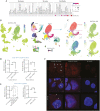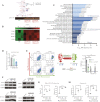GATA6-AS1 Regulates Intestinal Epithelial Mitochondrial Functions, and its Reduced Expression is Linked to Intestinal Inflammation and Less Favourable Disease Course in Ulcerative Colitis
- PMID: 36655602
- PMCID: PMC10274303
- DOI: 10.1093/ecco-jcc/jjad006
GATA6-AS1 Regulates Intestinal Epithelial Mitochondrial Functions, and its Reduced Expression is Linked to Intestinal Inflammation and Less Favourable Disease Course in Ulcerative Colitis
Abstract
Background and aims: Widespread dysregulation of long non-coding RNAs [lncRNAs] including a reduction in GATA6-AS1 was noted in inflammatory bowel disease [IBD]. We previously reported a prominent inhibition of epithelial mitochondrial functions in ulcerative colitis [UC]. However, the connection between reduction of GATA6-AS1 expression and attenuated epithelial mitochondrial functions was not defined.
Methods: Mucosal transcriptomics was used to conform GATA6-AS1 reduction in several treatment-naïve independent human cohorts [n=673]. RNA pull-down followed by mass spectrometry was used to determine the GATA6-AS1 interactome. Metabolomics and mitochondrial respiration following GATA6-AS1 silencing in Caco-2 cells were used to elaborate on GATA6-AS1 functions.
Results: GATA6-AS1 showed predominant expression in gut epithelia using single cell datasets. GATA6-AS1 levels were reduced in Crohn's disease [CD] ileum and UC rectum in independent cohorts. Reduced GATA6-AS1 lncRNA was further linked to a more severe UC form, and to a less favourable UC course. The GATA6-AS1 interactome showed robust enrichment for mitochondrial proteins, and included TGM2, an autoantigen in coeliac disease that is induced in UC, CD and coeliac disease, in contrast to GATA6-AS1 reduction in these cohorts. GATA6-AS1 silencing resulted in induction of TGM2, and this was coupled with a reduction in mitochondrial membrane potential and mitochondrial respiration, as well as in a reduction of metabolites linked to aerobic respiration relevant to mucosal inflammation. TGM2 knockdown in GATA6-AS1-deficient cells rescued mitochondrial respiration.
Conclusions: GATA6-AS1 levels are reduced in UC, CD and coeliac disease, and in more severe UC forms. We highlight GATA6-AS1 as a target regulating epithelial mitochondrial functions, potentially through controlling TGM2 levels.
Keywords: GATA6-AS1 long non-coding RNA; inflammatory bowel disease; mitochondria.
© The Author(s) 2023. Published by Oxford University Press on behalf of European Crohn’s and Colitis Organisation.
Conflict of interest statement
The following authors have no conflicts of interest: KES, TB, AA, MB, KLV, NL, HAE, KB, RBY, SAA, SRM, SK, IA, EGS, BW, IB, EG, TG, SBH, IU, LAD, YH. JSH: Advisory Board Janssen, consultant: Takeda, Pfizer, Bristol Myers Squibb, Boehringer Ingleheim, and Eli Lilly.
Figures





References
-
- Allou L, Balzano S, Magg A, et al. . Non-coding deletions identify Maenli lncRNA as a limb-specific En1 regulator. Nature 2021;592:93–8. - PubMed
MeSH terms
Substances
Grants and funding
LinkOut - more resources
Full Text Sources
Medical
Molecular Biology Databases
Miscellaneous

